
Best Things To See & Do In Toledo | Including Hidden Gems
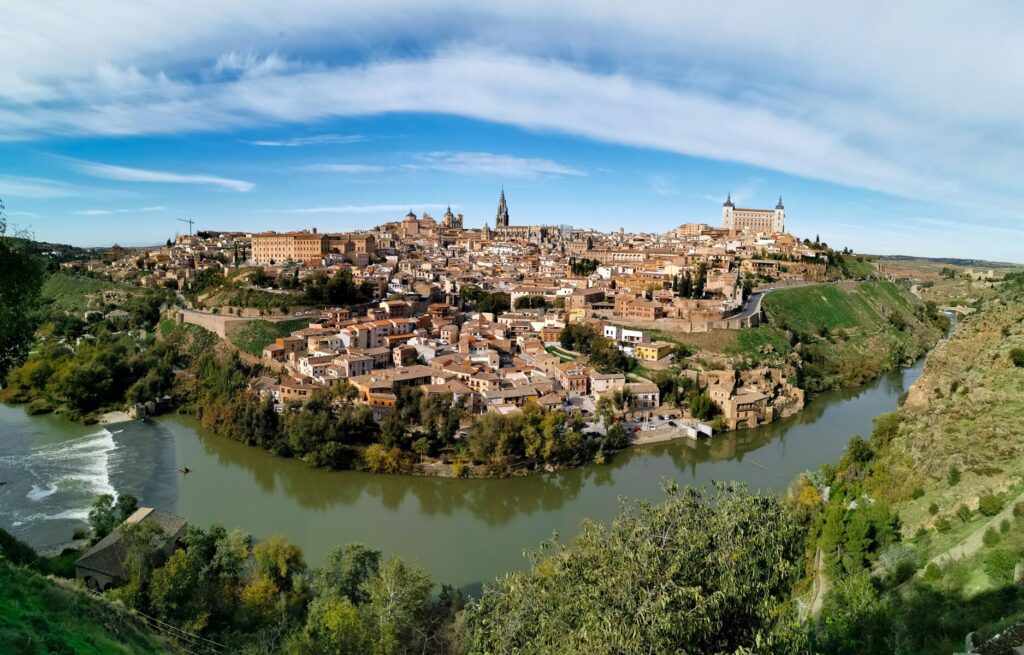
Toledo is perched on a rugged hill overlooking the plains of Castilla-La Mancha. Recognised as a UNESCO World Heritage site, Toledo is an open-air museum full of buildings and attractions all with centuries-old charm. In this blog post, I’ll take you through Toledo’s must-see landmarks and it’s hidden gems.
Why Visit Toledo
Toledo is a treasure trove of history and architectural wonders. Known as the “City of Three Cultures,” this enchanting destination showcases a harmonious blend of Christian, Muslim, and Jewish traditions, which is reflected in its winding streets and medieval buildings.
Adding to its cultural allure is the legacy of El Greco, the renowned Spanish Renaissance artist who called Toledo home. His masterpieces, many of which are displayed in the city’s museums and churches,
Conveniently located near Madrid, Toledo is the perfect destination for a day trip. Whether you’re exploring its medieval streets, marvelling at El Greco’s iconic works, or simply soaking in the city’s timeless charm, Toledo promises a unique glimpse into Spain’s rich and diverse heritage.
A Short History of Toledo
Toledo has a history that spans more than 2,000 years. Its origins trace back to Roman times when it served as an important administrative and military hub. Following the decline of the Roman Empire, Toledo rose to prominence as the capital of the Visigothic Kingdom in the 6th century.
After the Muslim conquest in the early 8th century, the city entered a golden age of cultural and intellectual exchange. Under Muslim rule, Toledo became a thriving centre of learning, attracting scholars from all over the world. This period left a lasting mark on its architecture and urban layout.
During the Christian Reconquista, in the 11th century, Toledo was reclaimed by King Alfonso VI. After which it emerged as a beacon of religious coexistence, with Christian, Muslim, and Jewish communities living side by side.
By the Middle Ages, Toledo was an intellectual hub, playing an important role in translating major works of science, philosophy, and literature into Latin and Arabic. Toledo’s cultural significance continued to flourish during the Renaissance, becoming a canvas for artistic and architectural masterpieces. This included the works of El Greco, who immortalised the city with his evocative paintings.
Over centuries, Toledo continued to transform. From being a melting pot of three major religions to becoming a symbol of Spain after the Reconquista. The city’s architecture — ranging from Gothic churches to Moorish mosques and synagogues tell stories of its layered history. By the 19th and 20th centuries, Toledo retained its historical charm while modernizing as a thriving cultural and tourist centre. Today, it proudly stands as a UNESCO World Heritage Site, with its timeless beauty, rich heritage, and vibrant history.
So, now let’s move on to the exciting part; all the best things to see and do in Toledo…
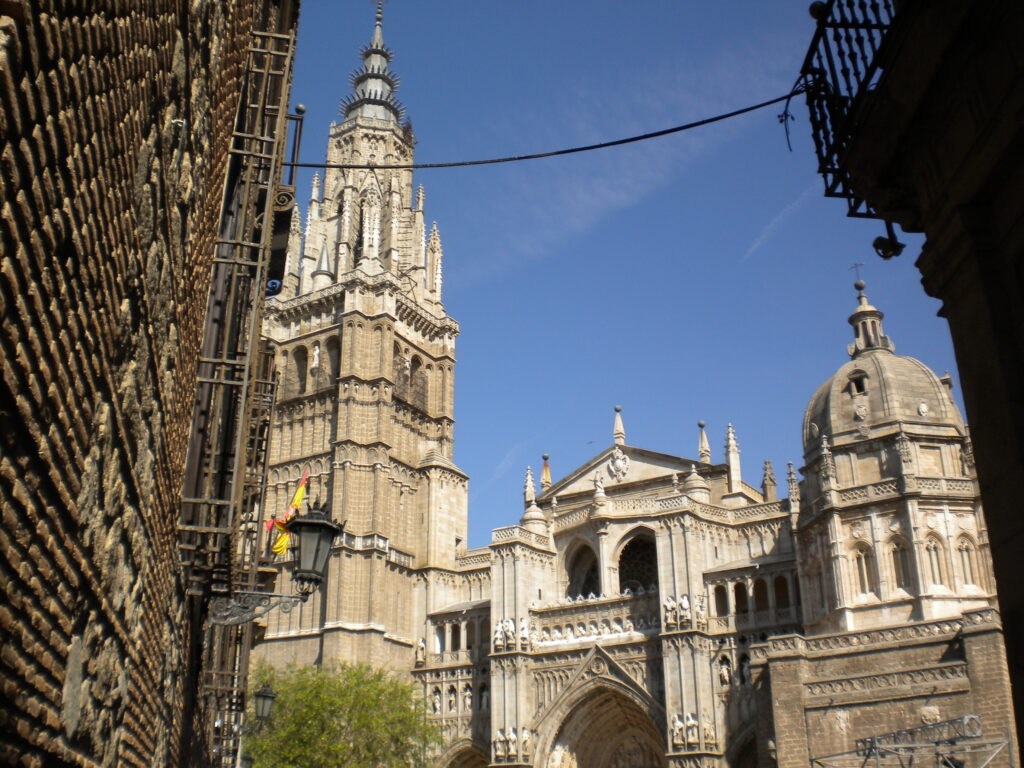
Visit Toledo’s Cathedral – Catedral Primada
This stunning cathedral is a living testament to the theological significance and the pastoral life of Toledo. Built between 1226 and 1493, this Catholic iconic symbol of Gothic architecture is one that you simply cannot miss when in Toledo.
What To See – Once inside, prepare to be captivated with its soaring ribbed vaults, intricate stone carvings, and stained-glass windows. Visiting the sacristy is also a must see. Functioning as an art gallery and is full of masterpieces, including works by El Greco’s, Titian, Velázquez, and Caravaggio.
Getting There – The cathedral is located right in the historic centre. This central location makes it easily accessible and a prominent landmark within the city’s medieval layout.
Tickets & Opening Hours – The cathedral is open Monday to Saturday from 10am – 6pm and on Sundays 2pm – 6pm. During holidays (Easter, Christmas), there may be adjustments to the opening hours,; so check the cathedral’s website. There is an entrance fee to visit the Cathedral and tickets can be purchased online or on entry.
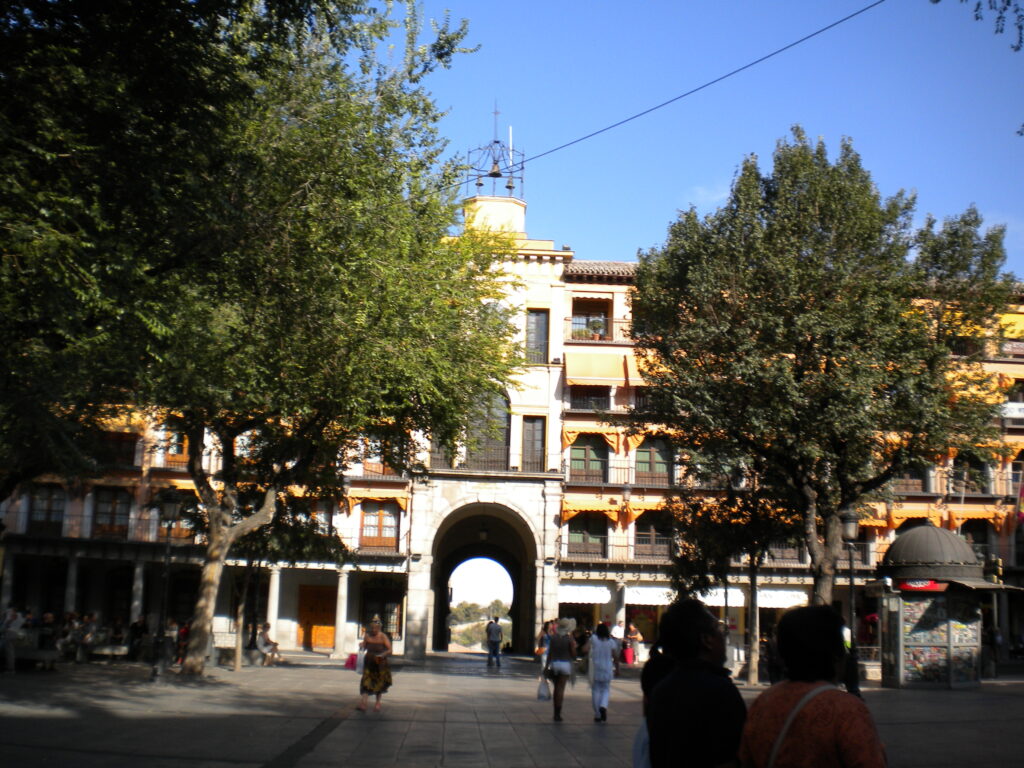
Visit Plaza Zocodover – The Main Square
Plaza Zocodover is also situated in the historic centre. The plaza traces its origins back to the period of Muslim rule from 711 to 1085. During the time, the square served as a vibrant Moorish market, bustling with merchants trading goods.
After Toledo’s Christian reconquest, the plaza retained its importance as a centre of commerce and civic activity. It hosted public celebrations, jousting tournaments, and even grim spectacles like executions.
Today, Plaza Zocodover remains a lively centrepiece. It is surrounded by shops and cafés making it the perfect spot to relax and soak in the atmosphere. Notable landmarks like the Alcázar and the Catedral Primada are just a short walk away.
Additional Tip – While you are there, make sure you wander the adjacent cobblestone streets for unique shops and hidden spaces.
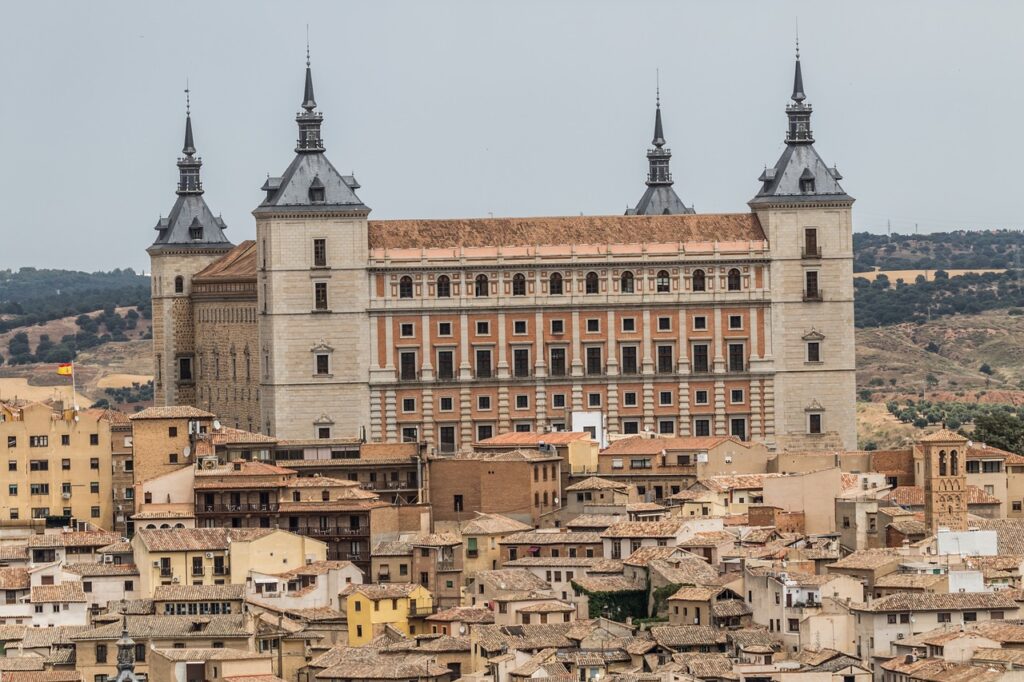
Visit The Alcázar – The Historic Fortress
Located at the highest point of Toledo’s historic centre, the Alcázar is an unmissable landmark that defines Toledo’s medieval skyline. Perched on a hill, this imposing fortress has played a central role in the city’s history. Its central and elevated location also means you’ll have great views of the city and the surrounding landscape.
Originally built as a Roman palace (in the third century), the Alcázar has been reconstructed and repurposed over centuries. It has served as a royal residence as well as a military fortification. The building gained particular historical prominence during the Spanish Civil War, becoming a symbol of resilience after a legendary siege.
Today, the Alcázar is the Museo del Ejército (Army Museum). It is full of fascinating artefacts, from ancient weaponry to modern military equipment.
Beyond visiting the museum, the Alcázar building itself is great to explore, with its courtyards, intricate carvings, and well-preserved interiors.
The Alcázar is open all year around, except for bank holidays. Opening hours are generally between 10am – 5pm. However, for the opening times check the website.
Finally, there is an entrance fee to visit the museum. However, if you just want to enjoy the views, then just visit the coffee shop located on the top floor.
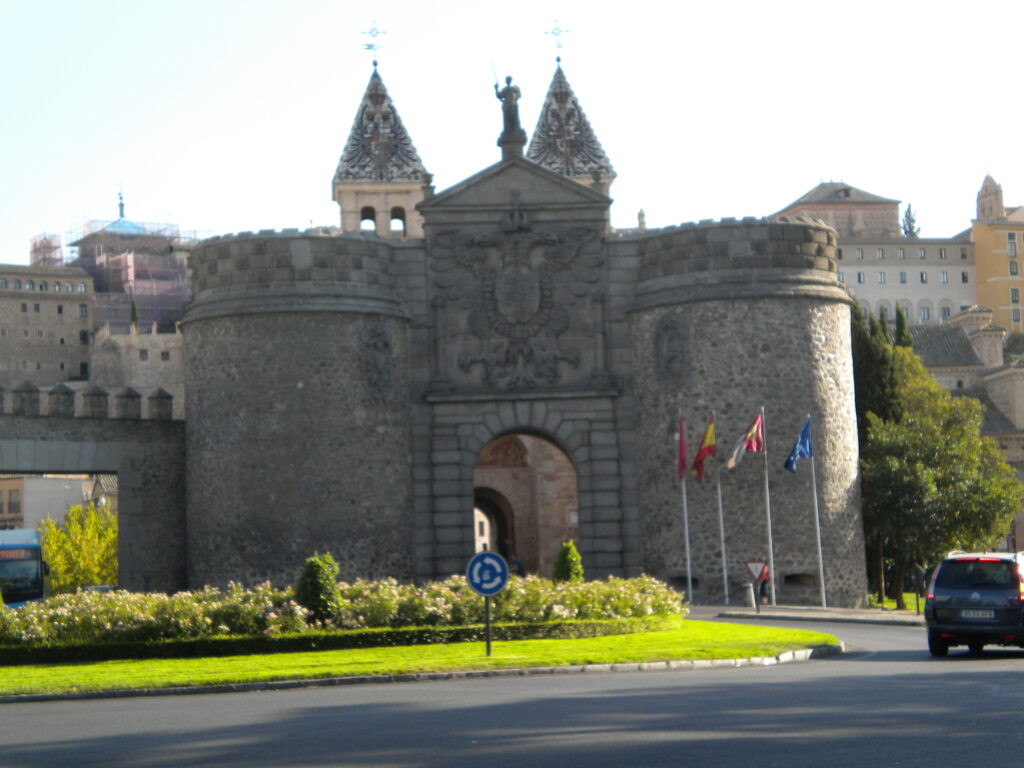
Walk Along The Ancient City Walls & Gates
Walking along the ancient city walls of Toledo is a must-do. These impressive walls, which wrap around much of the old town, trace their origins back to Roman times. Over the centuries, the walls were expanded during both Moorish and Christian rule.
As you explore the walls, you’ll encounter a series of magnificent gates and towers. One of the most famous is the Puerta de Bisagra. This gates serves as a grand entrance to Toledo with stunning Mudéjar architecture. Another great key gate to see is the Puerta del Sol, a 14th-century gate adorned with intricate carvings. Finally, the Puerta de Alfonso VI, offers a quieter yet beautifully preserved section of the wall. Here you can appreciate the medieval craftsmanship used to fortify the city.
Furthermore, walking along the walls provides some of the most breathtaking views of Toledo and its surroundings. A favoured route is along the Paseo de Recaredo. This pathway allows you to follow the walls while soaking in scenes of the Tagus River.
The majority of the city walls are easily accessible. However, wear comfortable shoes as the paths and steps can be rugged. Nearby, you’ll easily find amenities, such as cafes and shops, particularly around the bustling Plaza Zocodover.
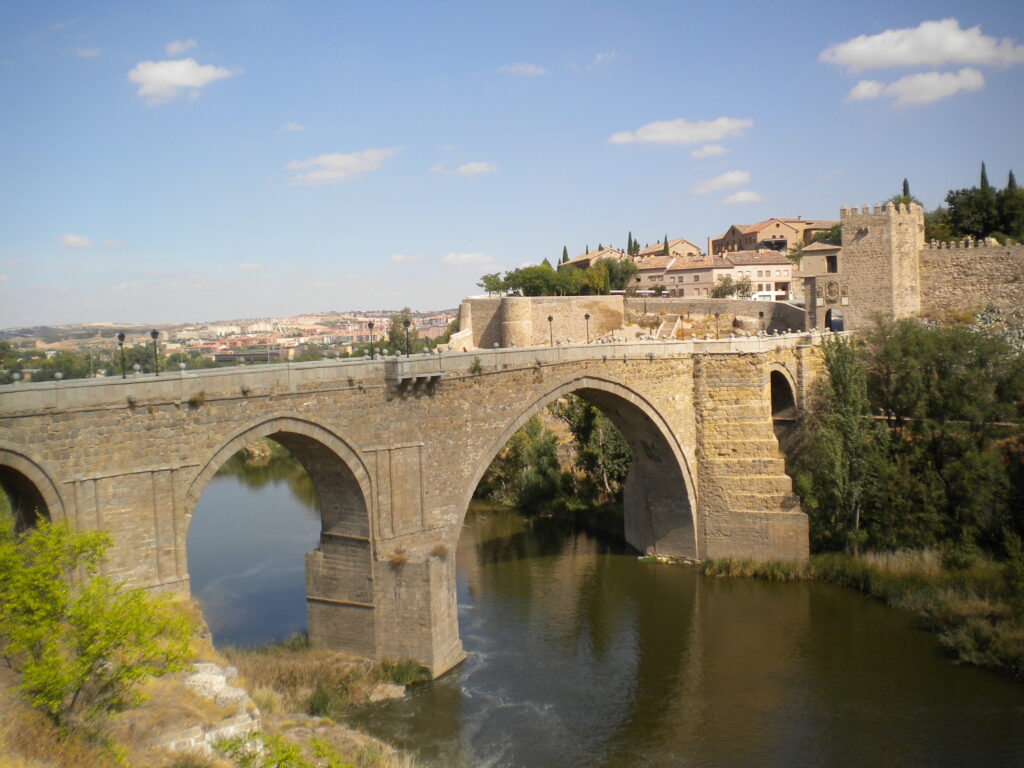
Visit The City’s Historic Bridges
Toledo has two great historic bridges that cross the Tagus river that are really worth visiting. These are the Puente de Alcántara and the Puente de San Martín.
The Puente de Alcántara is a Roman-built marvel. Although this bridge has been restored and modified over the centuries, it has retained much of its original Roman design. The bridge features strong arches and fortified towers, symbolising its former role as a defensive gateway into the city. Cross the bridge for great views of the Tagus River and city walls.
The Puente de San Martín offers a different but equally striking experience. This 14th-century bridge, built during the reign of King Alfonso XI, is an architectural gem with Gothic-style arches.
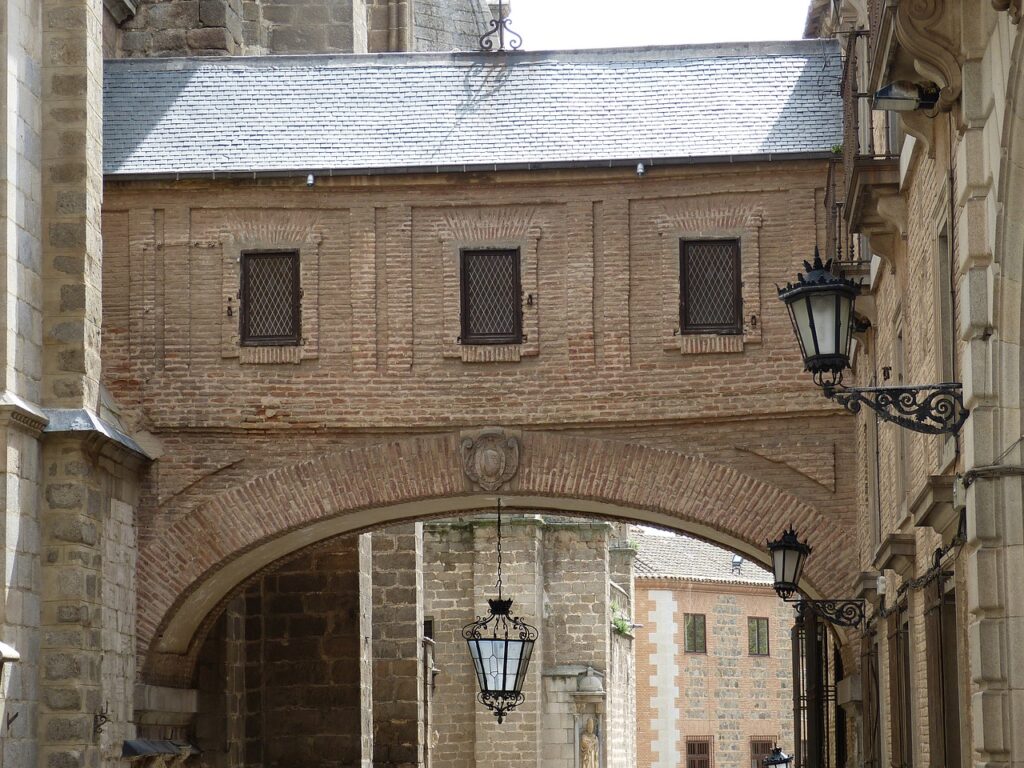
Walk Under The Cobertizos
The Cobertizos are a series of charming, medieval covered walkways. Scattered throughout the historic old town, these shaded passages once served as practical shelters from the intense Spanish sun. Among the most notable are the Cobertizo de Santo Domingo el Real and the Cobertizo de Santa Clara.
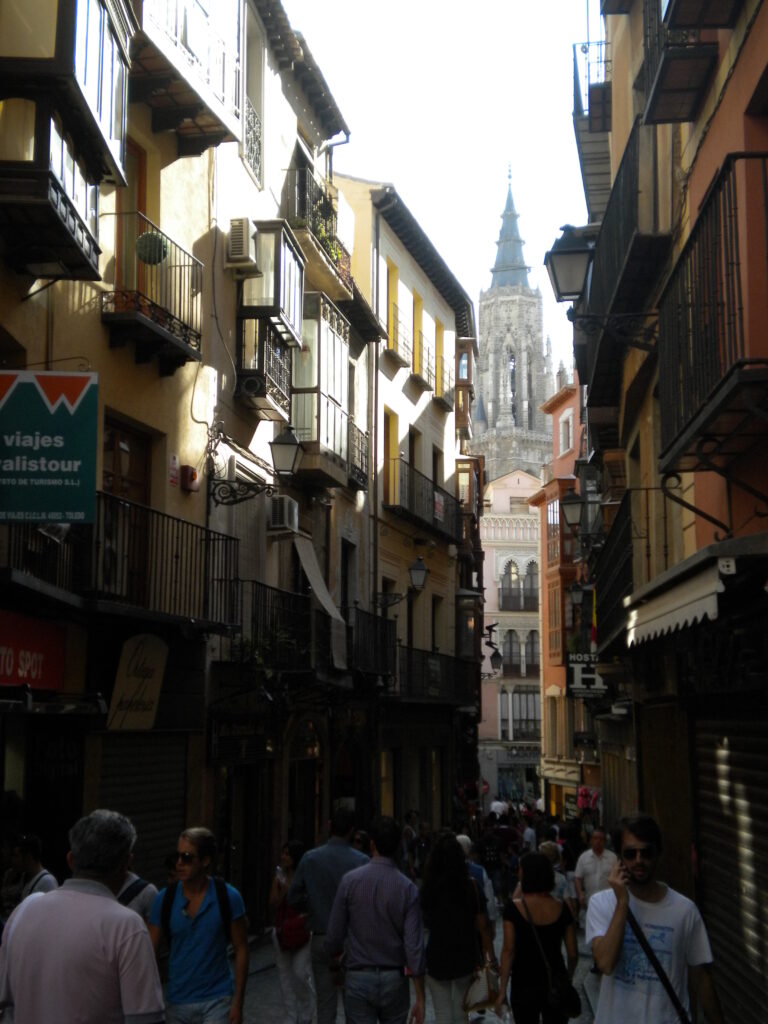
Walk Along Calle Santo Tomé & Visit El Greco’s Masterpiece
Toledo’s old town is full of streets dotted with stunning examples of Christian, Muslim, and Jewish architecture. Calle Santo Tomé is a one such street. Renowned for its architecture, is also full of speciality shops; particularly those selling Toledo’s famous marzipan; a traditional sweet treat made from almonds and sugar.
Confitería Santo Tomé, this historic confectionery is a must-visit if you have a sweet tooth. Established in 1856 and celebrated for its exquisite marzipan treats.
On Calle Santo Tomé you can also buy traditional Toledo crafts. These include damascene metalwork, a technique that involves inlaying gold or silver into steel to create intricate designs.
Calle Santo Tomé is also where you’ll find Iglesia de Santo Tomé. A beautiful church where you can see El Greco’s masterpiece, “The Burial of the Count of Orgaz”. This painting is considered one of the most significant works of art from the Spanish Renaissance.
Tickets & Opening Hours – The church is opened Monday to Saturday (10am – 5pm). Sunday opening hours are from 12pm – 5:45pm. The opening times can vary during holidays or special events. There is a fee to enter and tickets can be purchased at the counter.
Visit The Museum of Greco
This museum has an impressive collection of El Greco’s works. Works include the renowned “Apostolate” series, “The Tears of Saint Peter,” and the “View and Plan of Toledo.” These pieces highlight El Greco’s unique style, characterised by elongated figures and dramatic use of colour and light.
The museum also showcases pieces by artists inspired by El Greco, which are equally fascinating to explore. Additionally, it offers a recreated 16th-century Spanish home, providing a glimpse into the domestic life of the period.
Tickets & Opening Hours – The museum is open Tuesday to Sunday (closed on Mondays and public holidays) from 9:30am to 6pm. There is an entrance fee. Check the website for the latest information.
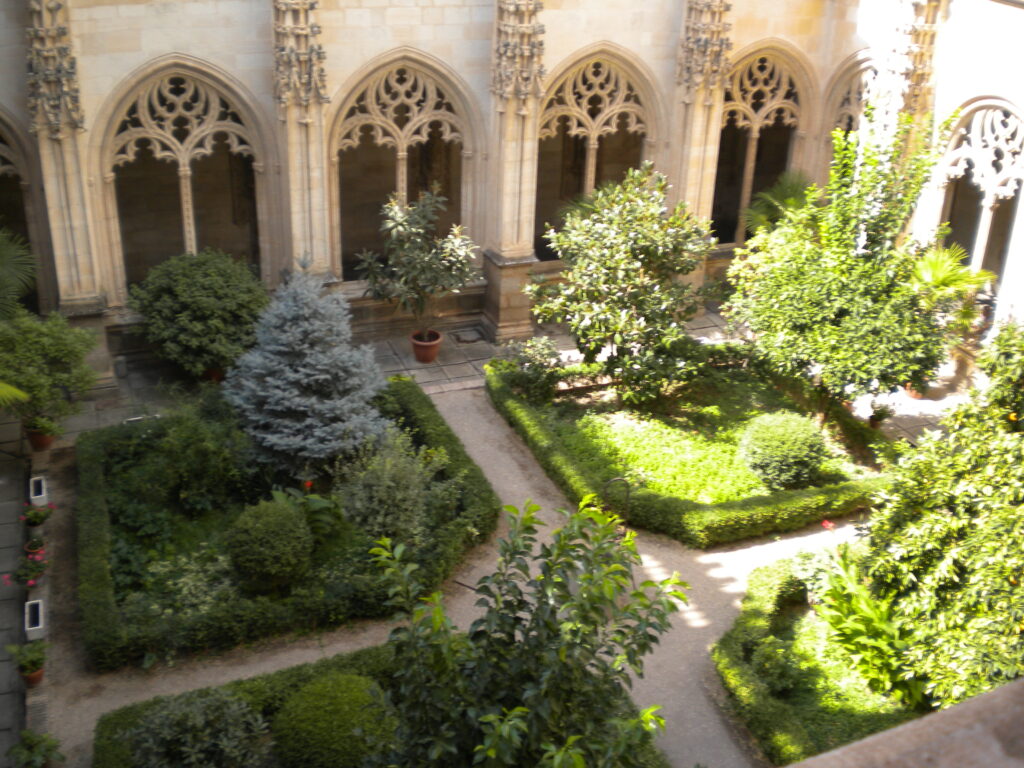
Visit Monasteries & Convents (Including The Burial Place Of El Greco)
Toledo is home to several remarkable monasteries and convents that are really worth seeing. These sites not only serve as places of worship but also house significant artworks and architectural marvels.
One of the most notable is the Convent of Santo Domingo el Antiguo. A Cistercian convent founded during the Spanish Reconquest and rebuilt in the 16th century. This convent is renowned for its collection of altarpieces and paintings by El Greco. It is also the burial place of El Greco himself.
The convent is open from Monday to Saturday, 11:00am – 1:30pm and then 4pm – to 7pm. Sunday opening hours are in the afternoon only (4pm-7pm). There is a small entrance fee. Tickets can be purchased at the entrance.
Monastery of San Juan de los Reyes is another worthwhile site for its stunning Gothic architecture. Commissioned by the Catholic Monarchs, its intricate cloisters and the impressive church are real highlights.
The monastery is open throughout the year. From March – October the opening hours are generally between 10am – 6pm. During the winter months, October – February, visiting hours are slightly shorter and generally between 10am-5pm. Ticket can be purchased at the entrance.
The Convent of San Clemente is another place worth a short stop. Although a closed convent, there is a small shop where you can purchase handmade goods made by the nuns. So a great opportunity to support the local community.
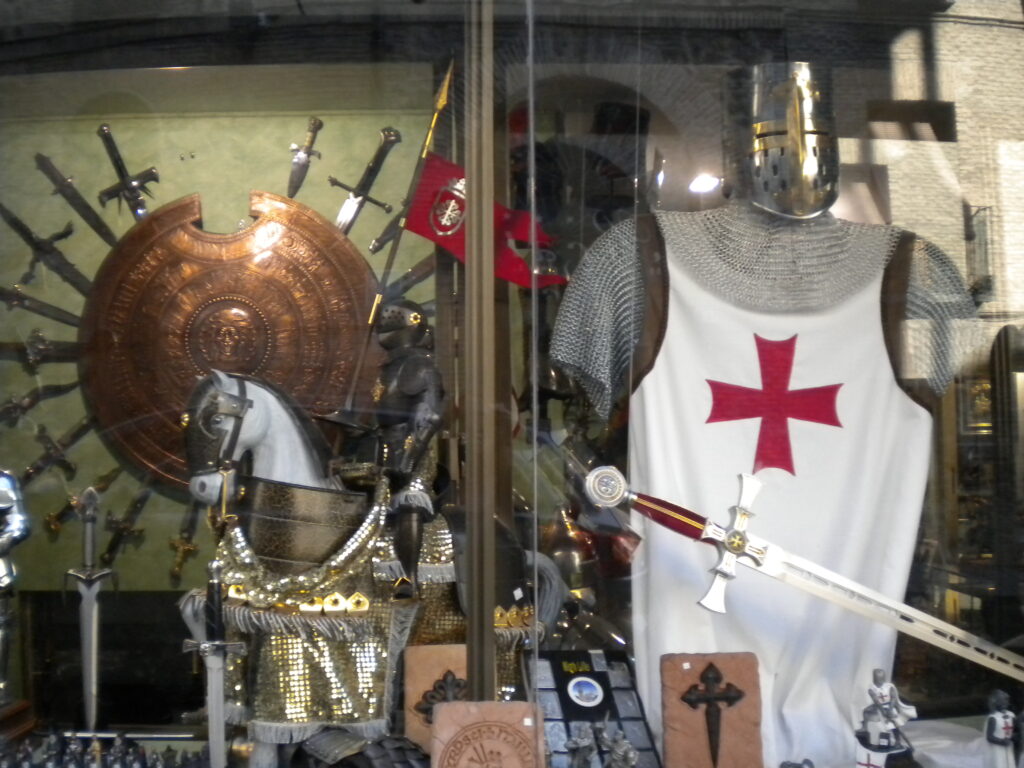
Take A Sword Making Workshop
Known for its exceptional steel and sword-making traditions, Toledo has been a centre of metalwork excellence for centuries. Visiting the city’s forges is a unique opportunity to witness the artistry and skill that have made Toledo’s blades famous worldwide.
One of the highlights of visiting Toledo’s steel forges is the chance to participate in a sword-making workshop. These workshops provide a hands-on experience where you can learn traditional techniques like forging, tempering, and polishing steel.
Explore Historic Synagogues & The Sephardic Museum
Two of the most historical synagogues in Toledo are the Synagogue of Santa María la Blanca and the Synagogue of El Tránsito.
The Synagogue of Santa María la Blanca, originally built in 1180, is a great example of Mudéjar architecture, a style influenced by Islamic design. Its interior is breathtaking, with rows of octagonal pillars supporting intricate horseshoe arches and white stucco ornamentation. In the 15th century the synagogue was converted into a Catholic church. Today, it is preserved as a museum, showcasing the blending of Jewish, Christian, and Islamic cultural elements.
Location, Tickets & Opening Hours – You will find this synagogue located on Calle Reyes Católicos, in the Jewish Quarter. Santa María la Blanca is open daily from 10am – 5pm during the winter months and until 6pm in the summer. The entrance fee is around €4 and tickets can be purchased at the front desk.
The Synagogue of El Tránsito, also known as the Synagogue of Samuel ha-Levi, and built in 1357. This synagogue stands out for its stunning interior featuring Nasrid-style stucco, wooden ceilings, and large multi-lobed arched windows. The intricate Hebrew and Arabic inscriptions decorating the walls reflect the multicultural influences of the time.
Today, it houses the Sephardic Museum, which shares the history of Spain’s Jewish communities through artefacts, documents, and multimedia exhibits.
Location, Tickets & Opening Hours – The museum is open from 9am – 3pm, Tuesday through Saturday, with morning only openings on Sundays. Tickets cost around €3 and can be purchased at the front desk.
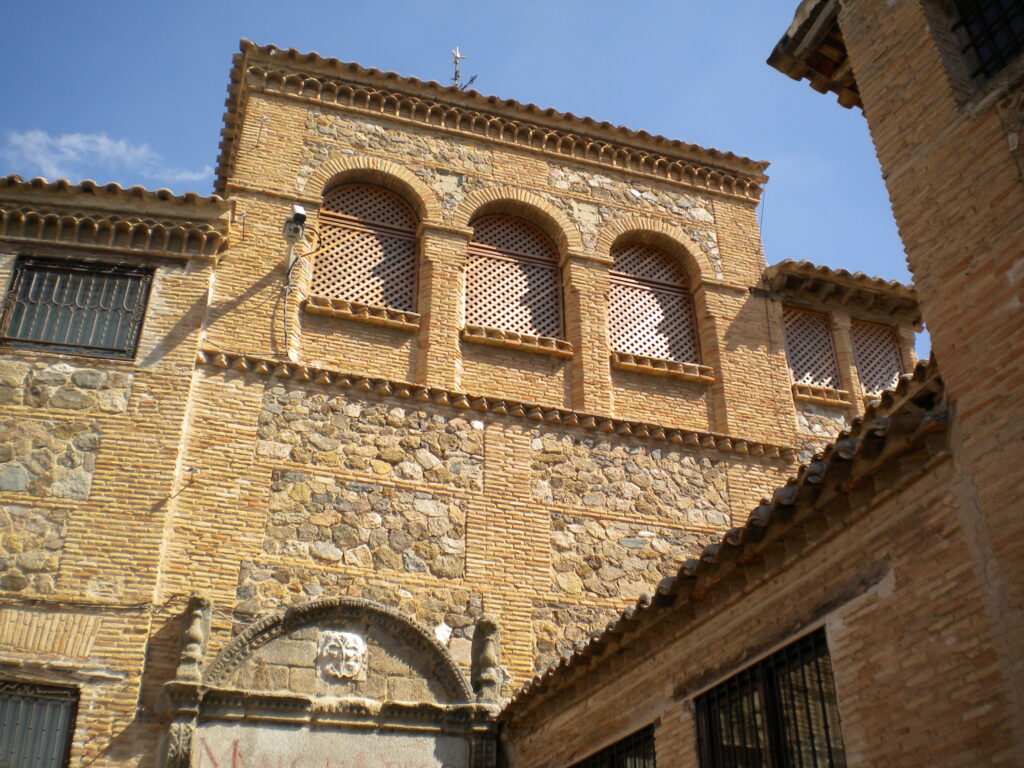
Visit The Museum Of Santa Cruz
Another of Toledo’s gems is the Museum of Santa Cruz. A former hospital turned into a multifunctional space showcasing art, archaeology, and ethnography. This museum is home to El Greco masterpieces, Visigothic artefacts, and intricate ceramics from the region. Its architecture alone, including a stunning cloister and an elaborate carved staircase, is worth the visit.
Location, Tickets & Opening Hours – Open daily except Mondays, it operating hours are generally 10-6pm. There is an entrance fee to pay and tickets can be purchased at the front desk.
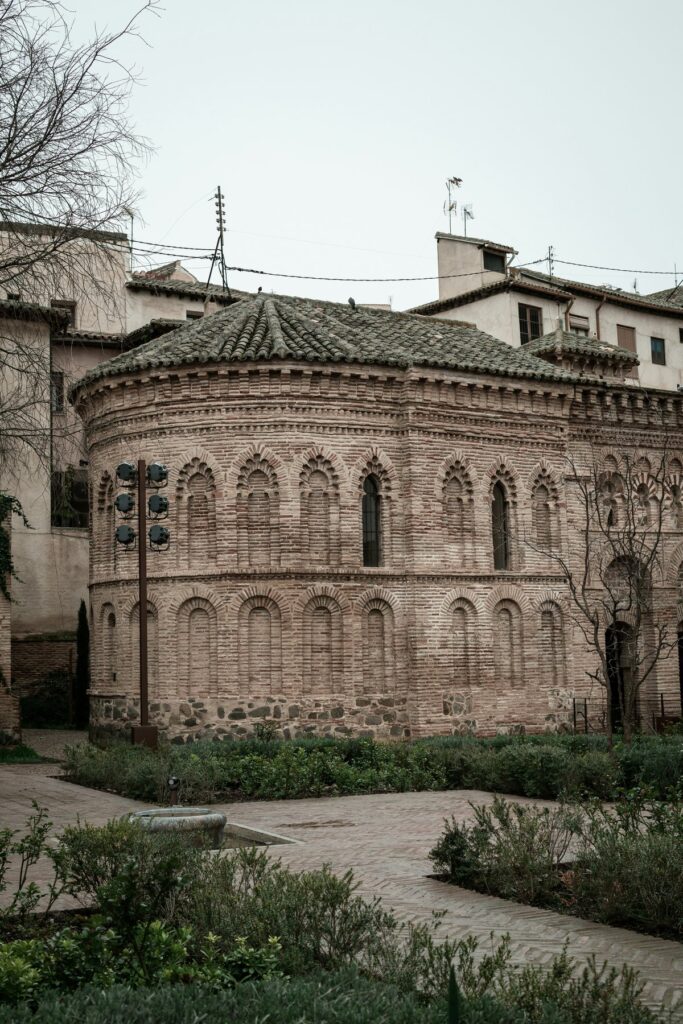
Visit The Mezquita del Cristo de la Luz
Toledo’s Mezquita del Cristo de la Luz is a remarkable blend of history, art, and spirituality. Originally built in 999 as a mosque, it’s the only surviving Islamic house of worship from Toledo’s Moorish period, making it a rare gem. Its name, translates to “Mosque of Christ of the Light,” reflects its transformation into a Christian chapel following the Reconquista in 1085.
The Mezquita retains its original Moorish horseshoe arches, delicate brickwork, and Islamic calligraphy, which blend with later Christian additions, such as the frescoes that adorn the walls.
Location, Tickets & Opening Hours – The opening times are generally between 10am-5pm. There is an entrance fee. Furthermore, as the place is small site, it won’t take long to explore.
Visit The Museum of Visigoths Councils & Culture
The Museum of Visigothic Councils and Culture offers a chance to understand a lesser-known yet pivotal chapter of Spain’s past. This museum is housed in the medieval Church of San Román, a building fused with both Romanesque and Mudéjar styles. The intricate arches and faded frescoes make the building an attraction in its own right.
The museum showcases the life the Visigothic period. This was a defining era from the 5th to the 8th centuries that shaped the cultural and political landscape of the Iberian Peninsula. Among the displays, your find carved stone reliefs and architectural fragments that once adorned Visigothic churches and buildings, showcasing the craftsmanship of the time.
The museum also has a fascinating selection of votive crowns and ornate crosses some adorned with delicate metalwork and intricate inscriptions, reflecting the era’s blend of religious devotion and regal opulence. These pieces offer a glimpse into the role of Christianity during the Visigothic rule and its influence on the Iberian Peninsula.
Location, Tickets & Opening Hours – Entry fee is typically around a few euros. The Museum is open Tuesday – Sunday. Closed on Mondays and bank holidays. Opening hours are from 10am-2pm and 4pm-6pm. Sunday opening hours are 9am-3pm.
Head To The Victorio Macho Museum
This musuem is about the life and works of one of Spain’s most renowned 20th-century sculptors; Victorio Macho. Housed in the artist’s former studio and home, provides a personal and immersive experience.
The exhibits feature many of his works, from monumental sculptures to intricate busts.
The outdoor garden and terrace are highlights in themselves, offering wonderful views of the river and the city.
Location, Tickets & Opening Hours – The museum is open Monday – Saturday 10am – 7pm and Sunday 10am – 3pm. Entrance is a few euros and again due to it’s size it does not take long to explore.
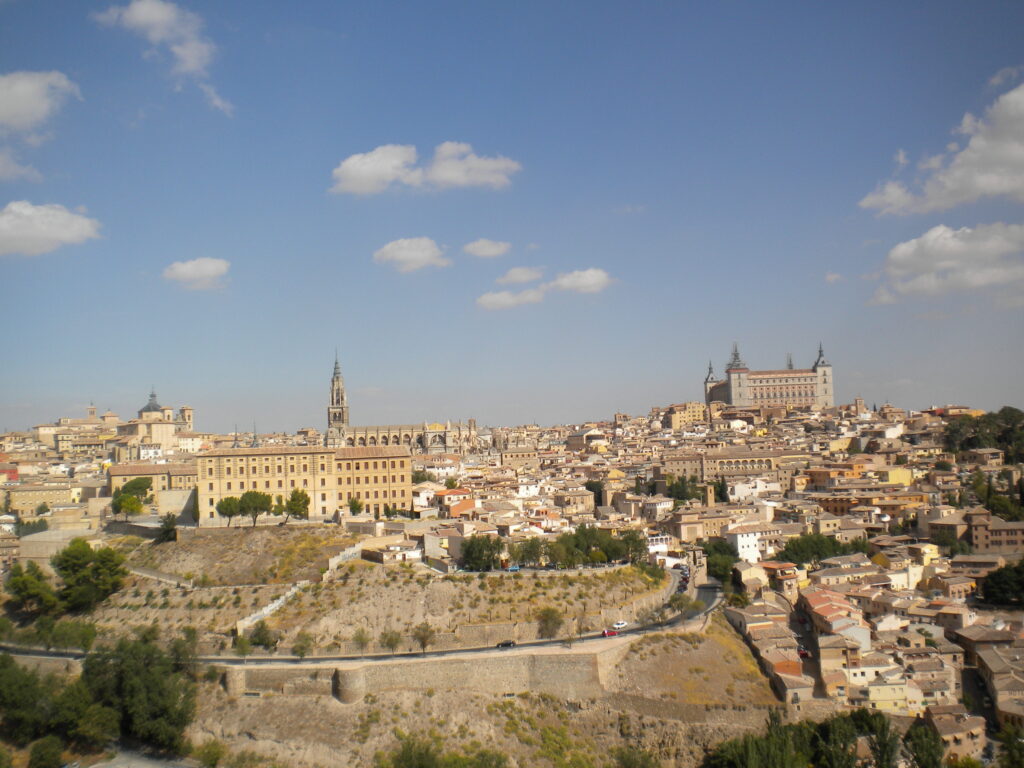
Take In The Best View At Mirador del Valle
Mirador del Valle is one of the most breathtaking viewpoints for a panoramic view of the history city. This spot offers a picture-perfect vantage point to appreciate the city’s blend of medieval, Moorish, and Renaissance architecture.
From this vantage point, you will have enjoy views of the ancient walls, bridges, and the Tagus River winding below. The landmarks of the city, such as the Alcázar and the Cathedral, stand out against a backdrop of rooftops and rolling hills. The view is especially enchanting at sunset when the golden light bathes the city. Whether you’re a photography enthusiast or simply looking to admire the landscape, Mirador del Valle is a must do.
How to Get There: Reaching Mirador del Valle is fairly simple. If you’re driving, it’s a short 10-15 minute drive, from the city with parking available nearby. For those without a car, taxis are readily available from the centre, and the ride is quick and affordable. Also hiking or cycling is also a popular method to get to the viewpoint.
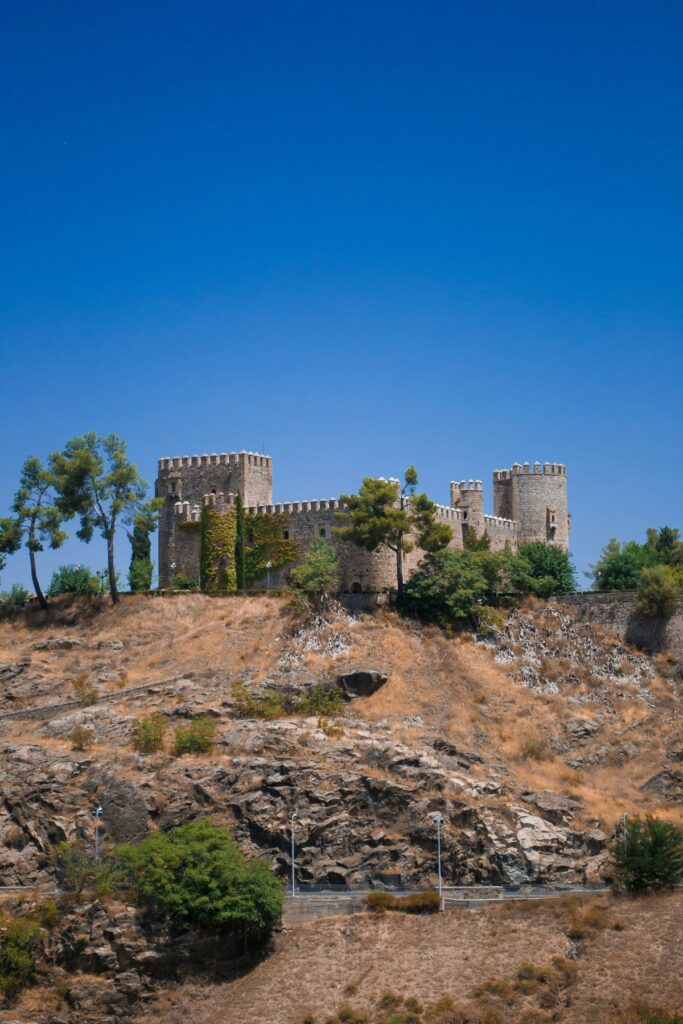
Visit A Medieval Castle – Castillo de San Servando
Perched on a hill overlooking Toledo, Castillo de San Servando is a fortress brimming with history and charm. Originally built as a monastery in the 11th century, it later became a fortress to safeguard Toledo during the Christian Reconquista.
The castle’s architecture is a blend of Christian and Moorish influences. The robust stone walls, towers, and battlements are remarkably preserved. Once inside, you can explore the interior courtyards and learn about the castle’s role as a defensive stronghold.
How to Get There: Castillo de San Servando is conveniently located just a short distance from Toledo’s city centre. If you’re driving, you can take the Avenida de Castilla-La Mancha—parking is available nearby. If you are arriving my train, the castle is a short walk (10-15 minutes) from the train station. For those preferring public transport, local buses frequently run to the area. Finally, hiking up to the castle is also an option and the trails are well marked.
Location, Tickets & Opening Hours – The castle welcomes visitors with opening times that vary based on the season. During the summer months, it’s generally open from mid-morning to early evening, while shorter hours may apply in winter. There is an entrance fee and tickets can be purchased at the front desk.
Visit An Historical Theme Park
Puy Du Fou España located on the outskirts of Toledo, is an extraordinary historical theme park. It offers an immersive experience through its live shows and reenactments that transport you into pivotal moments of Spanish history. With performances ranging from grand battles to intimate cultural tales, it’s a hit with both families and history buffs. Here you can wander through authentic-themed villages and enjoy unique dining experiences reflecting Spain’s rich heritage. It’s best to arrive early to make the most of the packed schedule of shows and explore the park at a relaxed pace.
The shows are primarily in the Spanish language. But non-Spanish speakers can still enjoy the experience, as the performances are highly visual and theatrical.
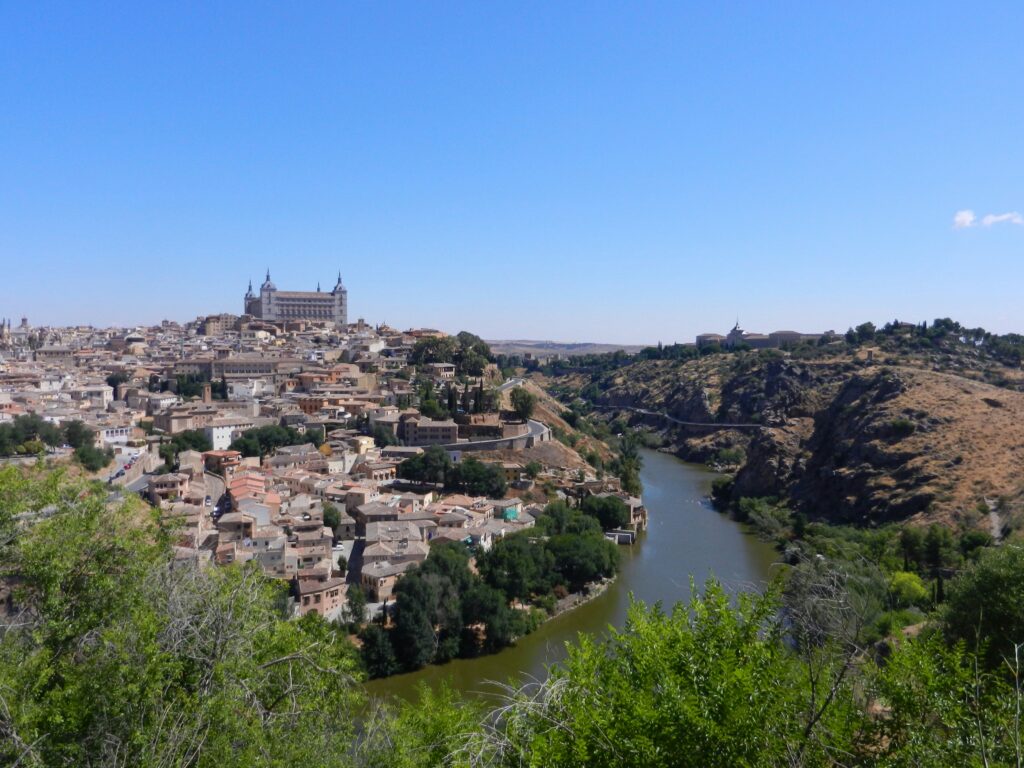
So To Wrap Up On The Best Things To See & Do In Toledo…
Toledo is a city that seamlessly weaves together history, culture, and breathtaking beauty. From great landmarks and hidden gems, I highly recommend a visit to Toledo – you won’t be disappointed.
For the best tour recommendations to take in Toledo, read our Best Tours In Toledo blogpost.
Further FAQs
Is There A Tourist Pass Available When Visiting Toledo
Purchasing one of Toledo’s city tourist passes is a smart way to save money; especially if you are planing on visiting several attractions.
The Toledo Tourist Bracelet (Pulsera Turística) is a popular choice. This bracelet grants access to around 7 of the major landmarks. These include the Church of Santo Tomé, Monastery of San Juan de los Reyes, and Mosque of Cristo de la Luz.
Alternatively, the Toledo Card offers more comprehensive benefits. These include entrance to the Cathedral and the Alcázar, plus skip-the-line privileges and guided tours. Specific passes are also available from Madrid, for day trippers. These passes provide value for money by bundling access to multiple sites and save you time not queuing for tickets. Make sure you research the best tourist pass for you.
How To Get To Toledo
Situated just 70 kilometres (about 44 miles) south of Madrid, making Toledo incredibly convenient to reach thanks to a variety of transportation options.
By Train – Taking the train is the most efficient and comfortable way to reach Toledo. The high-speed AVANT train, departs form Madrid’s Puerta de Atocha Station and journey time is only around 35 minutes.
Trains run frequently throughout the day, making it easy to plan a day trip or an overnight stay. Tickets typically range from €13 to €20 depending on how far in advance you book.
Upon arrival at Toledo’s train station, getting to the historic centre is a short taxi ride or about a 20 minute walk. Don’t forget to admire the station itself; a stunning Moorish style building.
By Train – Buses are another great option. Regular services are available from Madrid and the ride take around one hour. The costs are around €5 to €10, making it a very affordable choice. To note, that Toledo bus station is located a little further from the city centre than the train station. However, upon arrival you can easily catch a local bus or take a taxi to reach the historic centre.
By Car – If you prefer driving, renting a car is a great way to reach Toledo. The drive from Madrid takes about an hour via the A-42 motorway, a well-maintained and straightforward route. This option gives you the flexibility to stop at villages or scenic viewpoints along the way.
Parking in Toledo can be a bit tricky in the centre, but there are several carparks on the outskirts. From there, you can either walk, bus or taxi into the centre.
Driving is particularly appealing if you plan to visit other nearby attractions, such as Consuegra’s famous windmills or the castles of La Mancha.
To note, Toledo does not have its own airport, so the closest airport is Adolfo Suárez Madrid-Barajas Airport.
When To Go To Toledo
Spring (March – May) – Arguably the most delightful time to explore Toledo. The weather is mild, with temperatures ranging from 10°C – 20°C (50°F – 68°F). Flowers bloom over the city, adding vibrant splashes of colour to your photos. Spring is also festival season and brings Semana Santa (Holy Week), one of Toledo’s most significant religious celebrations. The celebration featuring solemn processions and centuries-old traditions. If you plan to visit during this time, book accommodation early as it’s a popular time.
Summer (June – August) – Summer in Toledo is hot—temperatures can soar to 40°C (104°F) on some days. Despite the heat, summer is a fantastic time to visit if you enjoy vibrant local culture and late evenings. The city comes alive with events like the Corpus Christi Festival, featuring colourful street decorations, parades, and religious ceremonies. Evenings in summer are particularly magical, thanks to outdoor dining and a lively atmosphere in Plaza Zocodover. While daytime sightseeing can be challenging, many attractions stay open until late, allowing you to explore once the heat subsides.
Autumn/Fall (September – November) – With temperatures settling between 15°C – 25°C (59°F – 77°F), makes it a comfortable season to visit.
Winter (December – February) – While temperatures can drop to 5°C (41°F), the crisp air and quieter streets make it also a good time time to visit. The festive atmosphere in December is especially captivating, with Christmas markets, lights, and celebrations adding a magical touch to the historic city.
How Much Time To Spend In Toledo
A day trip to Toledo is a popular way to visit. In one day you can explore many of the key landmarks including the Cathedral, the Alcázar, and the Jewish Quarter, while also enjoying panoramic views from the Mirador Del Valle. The city’s compact size and excellent train connections from Madrid make it perfect for a well-paced day trip.
However, if you have the opportunity to stay longer, an overnight visit or a full weekend allows you to dig deeper into Toledo’s rich layers of culture. Extended stays also give you time to savour the local food and explore at a more leisurely pace.
Where To Stay In Toledo
Whether you’re seeking luxurious five-star accommodations, charming boutique hotels, or cozy mid-range options, Toledo has something to offer. Here’s a guide to the best hotels in the city, their proximity to the historic centre, and what makes them worth checking into.
Disclosure: Please note that the hotel links below are affiliate links. At no extra cost to you, we earn a small commission from each booking that allows us to help maintain this website.
Five-Star Hotels
Eugenia de Montijo (Autograph Collection) – Located close to Toledo’s historic centre, this five-star hotel combines luxury with history. Housed in a former 16th-century palace, the property offers stunning interiors that retain the original architectural details.
Hotel Cigarral El Bosque – Perched on the edge of Toledo, this five-star gem offers spectacular panoramic views of the city. It’s a short drive from the historic centre, making it perfect if you want both convenience and additional amenities. The hotel features an outdoor pool, sprawling gardens, and a top-notch restaurant serving Spanish cuisine.
Mid-Range Hotels
Hotel Sercotel Alfonso VI – Situated right in the heart of Toledo’s historic old town, Hotel Alfonso VI is a great mid-range option. It’s just a short walk from top attractions like the Alcázar and Toledo Cathedral.
Hotel Carlos V – Another excellent mid-range choice is Hotel Carlos V, located mere steps from Plaza Zocodover — Toledo’s lively central square. Known for its rooftop terrace with views of the city’s spires and tiled rooftops, this hotel is a very good option.
Hotel Abad Toledo – This charming stone building dates back to 1815 is located next to the next to Puerta del Sol. Making it ideal for those that prefer a quieter stay but still want the local conveniences.
Boutique Hotels
Almunia de San Miguel – Located within a 5-minute walk from Toledo Cathedral, this hotel prides itself on its medieval-style design and intimate ambiance. The interior courtyard and terraces are great places to relax after a day’s sightseeing.
Hotel Boutique Adolfo – Set in the bustling Plaza Zocodover, Hotel Boutique Adolfo offers guests a blend of modern luxury and historic charm. Its central location makes it a great convenient choice.
Casa Palacio Rincón de la Catedral – This boutique hotel is built inside a renovated aristocratic home and is just a stone’s throw from the Cathedral. The property retains its historic elements, such as beamed ceilings and stone walls, while providing all the modern comforts.
Budget-Friendly Options
YIT Conquista de Toledo – A short walk from the Alcázar, this budget-friendly option offers clean, comfortable rooms and friendly service.
Hostal Sol – Provides basic yet comfortable rooms near Toledo’s Puerta del Sol gate. Its proximity to the historic centre allows easy access to the city’s landmarks.
For some great tips on booking hotel rooms, read the The Ultimate Guide To Booking Hotel Rooms blog post.

